Overview of breast cancer, breast pathology 1 and 2 – Flashcards
Unlock all answers in this set
Unlock answersquestion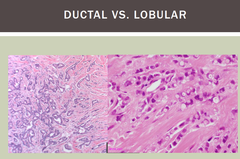
What are the malignant breast tumors?

answer
*Noninvasive* -Ductal carcinoma in situ (DCIS) -Comedocarcinoma -Paget disease of the breast *Invasive* -Invasive ductal carcinoma -Invasive lobular carcinoma -Medullary carcinoma -Inflammatory breast cancer
question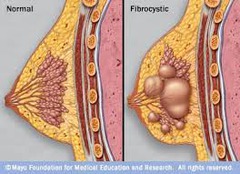
What are the benign breast disases?

answer
-Fibroadenoma -Fibrocystic changes --includes cystic, dilatory, metaplasia, and fibrosis -Sclerosing adenosis -Intraductal papilloma -Epithelial hyperplasia -Phyllodes tumor -Fat necrosis -Lactational mastitis -Gynecomastia
question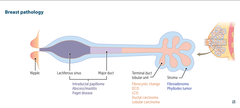
What is the basic anatomy of the Breast and the pathologies associated with each part?

answer
Lactiferous sinus/ Major duct --Intraductal papilloma -Abscess/mastitis -Paget disease Terminal duct/lobular unit -Fibrocystic change -DCIS -LCIS -Ductal carcinoma -Lobular carcinoma Stroma -Fibroadenoma -Phyllodes tumor
question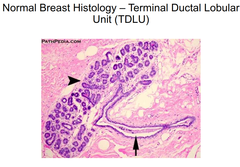
What is the basic anatomy of the breast?

answer
TDLU: -terminal duct-lobular unit where initial production and secretion of milk occurs Cooper's ligaments (suspensory) are connective tissue in the breast that help maintain structural integrity. PNS innervation for release T4 innervation for sensation Glands to fat are 2:1 in a lactating woman Lined by both Myoepithelium underneath an epithelial layer Drains to axillary ;
question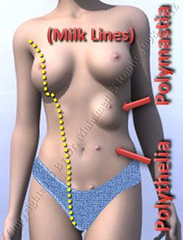
What is meant by the Milk line

answer
The milk lines are two lines, formed by thickenings of the epidermis along the ventral surface of mammals of both sexes. They extend from the upper limbs to the lower limbs and are developed in the embryo. They give rise to the mammary glands and nipples but are otherwise usually not visible in the adult. Polythelia refers to the presence of an additional nipple alone while polymastia denotes the much rarer presence of additional mammary glands. Although usually presenting on the milk line, pseudomamma can appear as far away as the foot.
question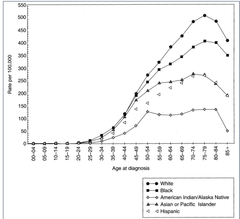
What are the risk factors for developing malignant breast tumors?

answer
-Increased estrogen exposure -Family history (primary relative) -Age --most common late 50's to mid 60's -Benign breast disease -Atypical hyperplasia -Radiation exposure -Total number of menstrual cycles --Late menopause/no OCP use -Older age of 1st live birth -Obesity --more conversion of androstenedione to estrone) -BRCA 1/BRCA 2 gene mutations --TP53 CHEK2 -African american ethnicity --Increased triple - breast cancer
question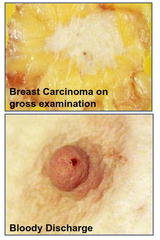
What is the clinical presentation of Invasive carcinoma of the breast?

answer
•Hard, fixed, irregular mass •Smaller -only vague asymmetry •Skin/nipple retraction •Skin invasion •Nipple discharge •Nodal mets •Distant mets (lung, liver, bone)
question
What conditions create calcification in breast tissue that is detectable via mammography?

answer
*Malignant* --Ductal carcinoma creates microcalcifications *benign* -Sclerosing adenosis -Fat necrosis -Fibroadenomas -Apocrine cysts
question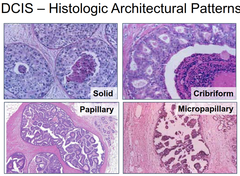
What are the characteristics of Ductal carcinoma in situ?

answer
An early breast malignancy without basement membrane penetration --Tumor cells fill ductal lumen. ' Arises from ductal atypia Often seen early as microcalcifications are seen on mammography lacks metastatic potential usually involves ONE duct system DCIS -Prognostic and Predictive Factors •Presence / Absence of Necrosis •Nuclear Grade •Extent •Margin Status
question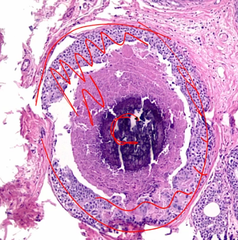
What is Comedocarcinoma?

answer
A subtype of DCIS seen with sheets of pleiomorphic high grade cells with central necrosis
question
What is Paget disease of the breast?

answer
malignant cells spread from DCIS into nipple skin w/o crossing BM. "Walks up" the ducts to the nipple --intra-epidermal spread Can be seen with eczematous patches on the nipple (red, crusted nipple/aerolar skin) Prognosis related to underlying lesion Paget cells = intraepithelial adenocarcinoma cells
question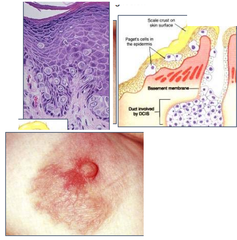
What are the characteristics of lobular carcinoma in situ?

answer
malignant proliferation of cells in lobules! NO invasion of BM. --often discovered incidentally --and does not produce mass or calcification rarer than DCIS (1-6% of all carc) --80-90% are premenopausal Risk factors for invasive carcinoma: •25 -35% of women over 20 -30 years time (rate of ~ 1% / yr) •Unlike DCIS, both breasts are at equal risk of developing cancer
question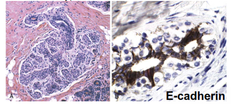
What is E-cadherin?

answer
A Transmembrane protein that contributes to the cohesion of normal epithelial cells •Loss of E-cadherin expression tied to lobular carcinoma --•Loss of 16q inactivation of e-cadherin gene, CDH1 (16q22.1) --•Tumor suppressor gene in breast •None of other 50 types of breast cancers show this alteration Loss of Cadherin usually causes greater Bilateral/multiple lesion presentation
question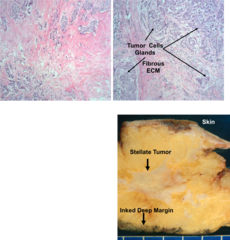
What is the appearance of ductal carcinoma on histology?

answer
Tubule/nest formation. Solid growth pattern (depends on tumor differentiation) -+ e-cadherin Has a Stellate infiltration pattern
question
What are the characteristics of Lobular carcinoma on histology?

answer
Made up of smaller cells with low nuclear grade, often in a single file due to lack of e-cadherin -"Indian filing" -Bilateral, multicentric apearance -Negative e-cadherin (CDH1) Metastasis often invovles meninges, peritoneum, GI tract, ovaries and uterus
question
What are the special types of invasive breast carcinoma?
answer
•10-15% of all breast cancers •Tubular •Invasive Cribriform •Mucinous (Colloid) •Invasive Lobular •Medullary •Micropapillary carcinoma
question
What is a Tubular carcinoma of the breast?

answer
A rare type of invasive ductal carcinoma of the breast It takes its name from its microscopic appearance, in which the cancer cells resemble small tubes. --Well differentiated ---Consists of well formed tubules , >90% of tumor Characteristics: -tend to be small, -- < 1 cm, but still mammo detected -estrogen-receptor positive -HER2/neu negative. In some cases, tubular cancer cells are mixed with ductal or lobular cancer cells, giving a mixed-tumor diagnosis Excellent prognosis -Low risk of local recurrence and distant metastasis -Good prognosis
question
What is an Invasive cribriform carcinoma (ICC)?

answer
a rare type of invasive breast carcinoma that exhibits a cribriform pattern in the majority of the invasive component, and is usually associated with an excellent prognosis. --Frequently mixed with tubular carcinoma (TC) --10-49% of another morphologic type along with •Excellent outcome -•10 yrsurvival (90-100%) -•Pure ICC> Mixed ICC> invasive carcinoma NST (best to worse) •Biologic behavior similar to tubular carcinoma
question
What is mucinous (colloid) carcinoma?

answer
A form of invasive ductal carcinoma that can be pure (;90%) or mixed) --2% of all breast carcinomas Presents with a soft gelatinous mass that is slow growing and well circumscribed Often occurs in older females (>55 years) Under a microscope, it looks like the cancer cells are scattered throughout pools of mucus •Good prognosis (10 yr survival > 80%) for pure mucinous carcinoma •Worse prognosis for mixed mucinous carcinoma
question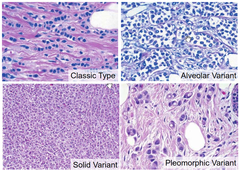
What are the characteristics of lobular carcinoma?

answer
•Histologic variants: •Classic type (most common), often low grade •Other variants: Solid, alveolar, pleomorphic, tubulolobular and mixed group •Usually ER+ (80-95%), PR+ (60-70%), Her2 + (rare) •Prognosis - •Classic type has more favorable outcome than solid and pleomorphic variants •Controversy in different outcomes between patients with ILC and invasive carcinoma NST •Some shows ILC has a more favorable outcome while others show no difference •Recent two large series show ILC has better or similar outcome than invasive carcinoma NST in the first 10 years; however, long term outcome associated with ILC is worse then invasive carcinoma NST
question
What is medullary carcinoma of the breast?
answer
a rare type of breast cancer that often can be treated successfully. It is marked by lymphocytes in and around the tumor that can be seen when viewed under a microscope. -This is the only breast cancer associated with a loss of function mutation in BRCA1, and thus the only form associated with a hereditary mutation. It is typically triple-negative and exhibits upregulation of p53. Presents with: - A fleshy, cellular, lymphocytic infiltrate -In younger females (25 % under 35) -;1 % of BC's Appears with aplasia, but actually has a good prognosis
question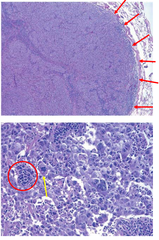
What is the diagnostic criteria for medullary carcinoma/Carcinoma with medullary features?

answer
•Diagnostic criteria a) syncytial architecture in ;75% of the tumor mass b) histological circumscription or pushing margins c) lack of tubular/glandular differentiation, d) a prominent and diffuse lymphoplasmacytic stroma infiltrate e) tumor cells with grade 2 to 3 nuclei (high grade vesicular nuclei containing one or several nucleoli) •Most studies indicate good prognosis compared with grade - matched invasive carcinoma NST
question
What is invasive micropapillary carcinoma?

answer
A rare form of invasive ductal carcinoma that can be pure or mixed Mean age of presentation similar to ER + invasive carcinoma --Majority are ER +, PR +, with Her 2 in <10 % to 35% More frequently presents with lympho-vascular invasion and lymph node metastasis On histology: -Hollow or morula-like aggregates of cuboidal-to-columnar neoplastic cells, surrounded by empty stroma
question
What is inflammatory carcinoma?

answer
One of the aggressive types of breast cancer that can occur in women of any age (and, extremely rarely, in men). It is called inflammatory because it frequently presents with symptoms resembling an inflammation. Seen with: -dermal lymphatic invasion by breast carcinoma -Pea d'orange -neoplastic cells block lymphatic drainage Prognosis : --poor , 50 % survival at 5 years --Often mistaken for mastitis or paget disease Microscopic features •Often high grade invasive ductal carcinoma •Dermal lymphatic invasion
question
What is the staging for breast cancer?

answer
*T -Tumor Size* •T1a ? 0.5cm •T1b 0.6 -1.0cm •T1c 1.1 -2.0cm •T2 2.1 ? 5.0cm •T3 > 5.0 cm •T4 Tumor extends to chest wall, skin, and inflammatory carcinoma *N -Regional Lymph Node* •pNX: Regional lymph nodes cannot be assessed (eg, previously removed, or not removed for pathologic study) •pN0: No regional lymph node metastasis identified histologically •pN0 (i-): No regional lymph node metastases histologically, negative IHC •pN0 (i+): Malignant cells in regional lymph node(s) no greater than 0.2 mm and no more than 200 cells (detected by H&E or IHC) •p N 1 m i : Micrometastases(greater than 0.2 mm and/or more than 200 cells, but none greater than 2.0 mm) •pN1: Metastases in 1 to 3 axillary lymph nodes, at least 1 metastasis greaterthan 2.0 mm (macrometastasis) •pN2: Metastases in 4 to 9 axillary lymph nodes, at least 1 tumor deposit greater than 2.0 mm •pN3: Metastases in 10 or more axillary lymph nodes, at least 1 tumor deposit greater than 2.0 mm *M1 -Distant Metastasis* as determined by classic clinical and radiographic means and/or histologically proven larger than 0.2 mm •Bone •L i v e r •Lung •Adrenal •B r a i n •Other Liver Mets
question
What are the prognostic factors connected to bast cancer?

answer
*PROGNOSTIC FACTORS* 1.Invasive vs In Situ 2.Distant mets (10% of patients) 3.Nodal mets (20% -30% of patients) 4. Tumor Size 5. Locally Advanced 6. Histologic Subtype 7. Tumor Grade (Nottingham grade) -Tubular formation -Nuclear grade -Mitotic activity 8. Lymphovascular Invasion 9. Receptor studies (immunohistochemistry)
question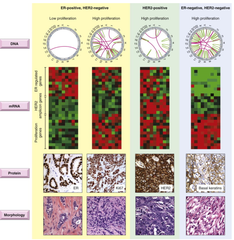
What are the prognostic factors connected to ER/PR tumors? Her2 receptors?

answer
*Estrogen (ER) and Progesterone (PR):* •Tumors with low to intermediate histologic grade have higher rate ER+/PR+ •80% of ER+/PR+ tumors respond to hormonal therapy •<10% of ER-/PR-respond to hormonal therapy *Her2/ neu status* -More frequent in aggressive tumors -Often node positive -Predicts response to Herceptin (monoclonal Ab against HER 2 neu) •Molecular subtypes of invasive carcinoma •Luminal A (ER+, HER2-, low proliferation):40%-55% •Luminal B(ER+, HER2-, high proliferation): 10% •Her2 (ER+low/-, HER2+): 20% •Basal-like (ER-, HER2-) :15%
question
What are the characteristics of the Luminal A molecular subtypes of invasive carcinoma?

answer
•ER+, HER2-, low proliferation •Most common subtype in *older women and in men* (40-55% of all breast cancers) •Low histologic grade •Good prognosis •Respond well to hormonal therapy
question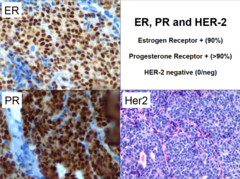
What are the characteristics of the Luminal B molecular sutypes of invasive carcinoma?

answer
•ER+, HER2-, high proliferation •10% of all breast cancers •ER and PR expression may be low •Most common type associated with BRCA2 Comprise 15-20% of breast cancers •More aggressive tumors compared to Luminal A •Higher histologic grade •Higher recurrence rate •Lower survival rate •Lower sensitivity to hormone therapy compared to luminal-A •10% show complete response to chemotherapy leads to indication of much better prognosis than patients that do not respond
question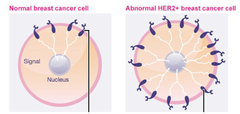
What are the characteristics of the HER 2+ (HER2 enriched) molecular sutypes of invasive carcinoma?

answer
•ER+low/-, HER2+ •Constitutes 20% of breast cancers •Most common subtype in germlinemutation of TP53 (Li-Fraumeni syndrome) •More aggressive biologic and clinical behavior •High histologic grade (>75%) •Harbor p53 mutation (40%) •May metastasize when small in size and early in course •Her2-targeted therapy: trastuzumab (Herceptin) •Markedly improve the outlook for patients with HER2 •May develop resistance to treatment
question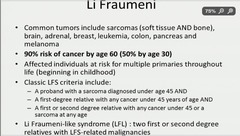
What is Li-fraumeni syndrome?

answer
Autosomal dominant predisposition to a variety of cancers, particularly sarcomas and tumors of the breast, brain, and adrenal cortex caused by mutation of the TP53 germline mutation associated with high risk of cancer before age 50
question
What are the characteristics of the ER-, HER2- (Basal-like) molecular sutypes of invasive carcinoma?
answer
•ER-, HER2 •Independent of ER-mediated changes in gene expression and Her2 gene amplifications •15% of all breast cancers •Most common in *young premenopausal* women •Most common type in BRAC1 deficient tumors •High histologic grade (poorly differentiated) with lymphocytic infiltrate and *medullary features* •Poor prognosis •Metastasize early (viscera, brain) •Recurrence usually within 5 years •30% may complete respond to chemotherapy
question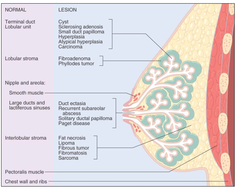
What are the stromal breast tumors?

answer
*Intralobularstroma* Fibroadenomas Phyllodestumors *Interlobularstroma* Myofibroblastomas Lipomas Angiosarcomas Pseudoangiomatausstromal hyperplasia (PASH) Fibromatosis
question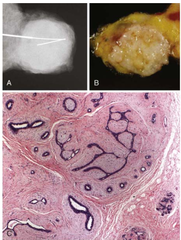
What is a breast fibroadenoma?

answer
•Benign biphasic tumor ---Stroma & ductal epithelium Reproductive Age •Most common benign tumor •20's -30's - •Single or multiple •G r o s s -•Spherical -•Circumscribed -•Usually 1 -4cm --well defined Size and tenderness increase with estrogen (pregnancy, prior to menstruation) Risk of cancer usually not increased
question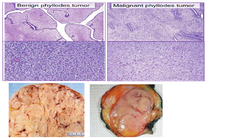
What is a phyllodes tumor?

answer
•Fibroepithelial neoplasm characterized by a hypercellular stromal component and leaf-like growth pattern •Gross appearance: well circumscribed, whorled appearance, *cleft-like spaces resembling leaf* •Classified into benign, borderline and malignant Most common in the 5th decade
question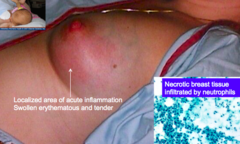
What is lactational mastitis?

answer
Inflammation of the breast tissue that occurs during breast tissue --cracks may increase risk of infection by bacteria like Staph. Aureus Treat with antibiotics and continue breastfeeding to reduce inflammation
question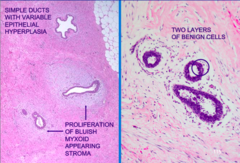
What is gynecomastia and what causes it?

answer
Breast enlargement in males due to increased estrogen compared with androgen activity Physiologic (not path) in newborns, pubertal, and elderly males, but may persist after puberty other causes include: -cirrhosis -Hypogonadism (klinefelter) -Testicular tumors -Drugs --Spirinolactone --Hormones --Cimetidine --ketoconazole "Some hormones creat knockers"
question
what are the risk factors for male breast cancer?
answer
•Older age •Family history •? Testicular function •Exogenous estrogens •Radiation •Obesity •Western country •BRCA2 •Klinefelter'ssyndrome Gynecomastia -NOT considered a risk factor
question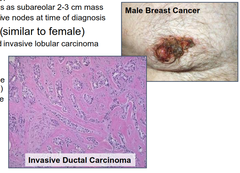
What are the tumor types and characteristics of breast cancer in men?

answer
•Anatomy •Nipple, duct system (like prepubertal female breast) •No significant lobule formation •Incidence of Cancer •Lifetime risk ?= 0.1% ?= 13% •Ductal carcinoma in situ •Invasive ductal carcinoma, NST --•Most common type of invasive breast cancer in male --•Usually presents as subareolar 2-3 cm mass --•50% have positive nodes at time of diagnosis Male Breast Cancer •Special types (similar to female) --•Rare in-situ and invasive lobular carcinoma --•80% are ER+ •Prognosis --•Similar to female (stage for stage) --•Often high stage Invasive Ductal Carcinoma
question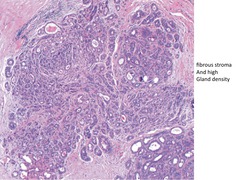
What is sclerosing adenosis of the breast?

answer
An increase in acini and stromal fibrosis in the breast --associated with calcification has a slight (1.5-2x) increased risk for cancer present when the number of acini per terminal duct is greater than twice the number found in uninvolved nodules
question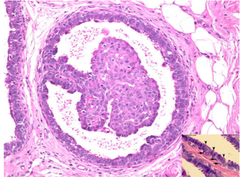
What is a intraductal papilloma?

answer
A small papillary tumor within lactiferous ducts, typically beneath the areola Most common cause of nipple discharge (Serous or bloody) Slight (1.5 - 2x ) , increased risk of cancer



